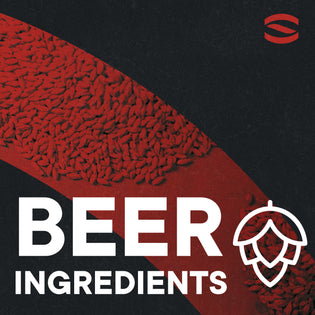Beer is one of (if not) the most popular alcoholic beverage in the US and abroad. With this level of demand, many are eager to brew their own beer. But, amidst this eagerness, most people still don’t get it right.
But never fear, Spike is here to make sure you’re in the clear!
Afterall, brewing beer isn’t dark magic, all you need is the proper guide. It’s something anyone can try and succeed if given adequate information and necessary tools. Continue reading for a step-by-step explanation of everything you need to know to get going. And, if you wish to learn more about brewing your beer, we have you covered.
In this article, we’ll take a closer look at:
- How to brew beer
- What is brewing?
- Why is it important?
- FAQs

A Little History Brewed Up
Beer has a wonderful history in addition to having a nice flavor. There is evidence of recipes dating back centuries, indicating that brewing has been around for thousands of years in some form. However, beer brewing has transformed over the years, thanks to the evolution of technology.
The procedure of beer brewing is methodical and measured, but there is also room for personal interpretation and the development of truly original beers due to the haziness of the rules and any potential limitations.
It sounds like it would be challenging, don't you think? Well, it isn't. You have total control over the kind of beer you want.
What Is Brewing And Why Do It?
Simply put, "brewing" is the process of controlling the interactions between water, starch, yeast, and hops to produce beer. The grains, usually barley, are first malted, which means they are allowed to germinate and then dried. They are then crushed and mixed with hot water to create a sweet liquid called wort. Hops are added to the wort to give the beer its characteristic bitterness, flavor, and aroma. The wort is then cooled and yeast is added to begin the fermentation process, which converts the sugars in the wort into alcohol and carbon dioxide.
The resulting liquid is beer.
There are many reasons why people make beer. While some people appreciate the flavor and diversity of various beers, others enjoy the process of making something from scratch. Making your own beer with friends and family can make brewing a fun social activity. Some people also brew beer as a hobby or as a means of producing distinctive beers that are hard to find in stores. Additionally, it could be for commercial purposes.

Is It Hard To Brew Your Own Beer?
How hard was it when you made your first pizza? Perhaps a different ball game, but if you’re a big lover of home brewing, you may be relieved to learn that making beer is much simpler than you can imagine.
Making your beer can be as easy, or as difficult, as you want to make it. The process can be as easy as combining the components, waiting for fermentation to take place, and then bottling the finished product. Basic kits are available for beginners that include all the essential tools and ingredients.
Brew Tip: New to the process? Take the Spike New Brewers Quiz to get started!
However, to produce more complex and subtle beers, some more sophisticated methods and techniques may be applied, some of which may need for additional tools and training. Overall, it can be a rewarding and enjoyable hobby, but learning the fundamentals and honing your skills do take some time.
Brew Tip: Been brewing for awhile? Check out what you need as the Advanced Brewer. But, if you’ve surpassed even that – then you have to see what Spike offers for the Pro Brewer.
What You'll Need To Brew Your Own Beer
Well, you’re not launching a rocket into space. What you need to brew your beer is readily available. Trust me, it is not as hard as you might be thinking.
To brew your beer, you will need;
- Brewing Equipment: This includes a fermenting bucket or carboy, a large pot for boiling the wort, and bottles or a keg for storing the finished beer.
- Ingredients: Such as malt extract, hops, yeast, and water. Depending on the recipe you're using, you may also need additional ingredients such as specialty grains, fruit, or spices.
- Sanitizing Solution: This is to clean and sanitize all of your equipment before and after brewing.
- Basic Kitchen Equipment: Such as a large spoon, a thermometer, a hydrometer, and a funnel
- Some basic tools such as a bottle filler, a capper, and a bottle brush.
It is important to have a brewing manual or recipe and brewing software to help you track your brewing process and make adjustments to your recipe if needed.

Beer Brewing Supplies
With the proper equipment and tools, brewing can be made much simpler. For someone new to the activity, there are so many different brewing equipment and accessories available that it can be a little bewildering. To help you get started, you can check out our various brewing accessories that are appropriate for your needs.
The basic supplies needed for beer brewing include:
- Brewing Equipment (brew kettle, fermenter, airlock, thermometer, spoon/paddle, etc.)
- Ingredients (grains, hops, yeast, and water)
- Sanitizing Solution (to clean and sanitize all equipment before use)
- Bottling Equipment (bottles, caps, a bottling bucket, and a bottle filler)
- Optional: a hydrometer (to measure the specific gravity of the beer and determine alcohol content)
Some other items that can be useful include a wort chiller (to quickly cool the beer after boiling), a carboy (for fermenting larger batches), and a keg (for draft beer).
Steps In the Brewing Process
We can’t discuss beer brewing without the process! Here is a step-by-step brewing process to follow:
1. Sanitizing
Even though it might not be the most interesting aspect of brewing, it is the most crucial. A brewer wants to make beer, not have a batch ruined by contamination that could have been prevented.
To minimize spoiling and unpleasant flavors in the beer, you must thoroughly clean and sanitize your workspace before you start brewing.
Two different cleanings are required for each step of the brewing process: one for the removal of dirt and grime and the other for surface sanitization.
2. Mashing
The term "mashing" describes the procedure by which enzymes in the grain transform complex starches into sugars, which can be converted into alcohol. The grains are steeped in heated water using a "Mash Tun" for an hour, often at a temperature between 149°F to 154°F (or, 65°C to 68°C).
After the grains have been thoroughly mashed, they are "rinsed" with fresh, warm water to extract all of the sugars.
3. Boiling
This concentrates, sanitizes, and considerably alters the final wort composition, which in turn affects many aspects of the finished beer's flavor, body, and palate fullness. Delicious hops are also added here.
4. Cooling
The wort is hot after boiling and needs to be cooled before the yeast is added after which the fermentation process starts. The heat exchanger will transport the cleared wort to the fermentation tank. The wort rapidly cools as it flows through the heat exchanger, depending on the type of beer being made.
After, the wort enters through the hot water inlet on one side of the heat exchanger, while cold water or glycol flows through the cold water side of the heat exchanger to remove heat from the wort.
5. Fermentation
This occurs in a fermentation tank with the addition of unique brewing yeast. The yeast converts the malt sugar into alcohol and carbon dioxide. When the malt sugar has finished fermenting, the yeast sinks and it’s gathered. Beer can be top or bottom-fermented, depending on the yeast used and how the wort was prepared.
Although we don't have perfect control over the fermentation process, temperature control is crucial to the success of the process and the quality of the final product.
If you’re looking to add more complexity to your beer using yeast, take a read on our guide: Using Yeast For Beer Complexity.
6. Bottling
Bottles must be sanitized and cleaned, just like every other component of brewing. Thankfully, doing so can be as simple as giving them a hot wash in a fresh dishwasher. Glass or plastic bottles can be recycled to make the activity even more environmentally friendly.
Once the batch has been bottled, keep each bottle for at least two weeks in a cold, dark location. As a result, the beer can complete its final conditioning process and the yeast can ferment the priming sugar to create carbon dioxide that will carbonate the beer.
7. Aging
The aging process for beer involves storing it at a controlled temperature and humidity for some time, usually several months. This allows the flavors and aromas of the beer to develop and mature and can result in a smoother, more complex taste.
However, not all beers are suitable for aging, and some can go bad if stored for too long. It is important to store the beer in a cool, dark, and dry place, and to ensure that the bottles are not exposed to light or heat.
Advanced Techniques
Some of the techniques in the brewing process include:
- Temperature Control: Maintaining specific temperatures during the brewing process can greatly affect the flavor of the final product.
- Water Chemistry: Adjusting the mineral content of the water can impact the taste and quality of the beer.
- Yeast Management: Using different yeast strains and controlling the fermentation temperature can yield different flavor profiles.
- Dry Hopping: Adding hops to the beer after fermentation can add aroma and flavor.
- Barrel Aging: Storing beer in oak barrels can impart distinct flavor characteristics and complexity.
- Blending: Blending different beers or beer styles to create unique and complex flavor profiles.
- Experimentation: Experimenting with unconventional ingredients and methods, such as using wild yeast or bacteria, or aging beer in unusual vessels like tequila or wine barrels.
FAQs
What is the easiest beer to brew?
The majority of homebrewers consider ale as the easiest beer to brew. Ales are among the most straightforward types of beer to brew because they are so simple to salvage. American Wheat Ale, American Brown Ale, American Pale Ale, and Porters are more beers that beginners should try.
Is it cheaper to make beer or buy it?
Making your beer is less expensive than purchasing it from a store. But, It's important to take into account the equipment costs as well as the time and labor required to make beer at home.
How long does it take to brew beer?
The specific time frame can vary depending on the type of beer and the brewing method used. For example, some beers, such as lagers, may take several weeks to ferment and condition, while others, such as ales, may be ready to drink in as little as one week.
How long does homemade beer last?
Homebrew lasts for about a year without losing much of its flavor. After bottling, the flavor continues to get better for a month or two, then stabilizes for a few months before degrading and going stale after around a year.
What is the quickest beer to brew?
The quickest beer to brew is usually one that uses yeast strains that ferment quickly and needs little time to age. American wheat beers, blonde ales, and some lagers are a few examples of these types of beers. Within 1-2 weeks, these beers can be fermented and served.
Final Thoughts: You’re Clear To Beer
Brewing beer can be simple and complicated, it is entirely down to what you do, how you do it, and when you do it. One thing is certain, you can always do it right. But, with the appropriate guide and supplies.
To brew your beer, you will need to gather the necessary equipment and ingredients, including a brewing kettle, fermenter, bottles or keg, hops, malt, yeast, and water. The basic process involves heating water, adding malt and hops, and then fermenting the mixture with yeast.
Once fermentation is complete, the beer can be bottled or kegged and left to carbonate. With practice and experimentation, you can create a wide variety of delicious beers in the comfort of your own home.
If you’re looking to start brewing your beer, or probably still sitting on the fence thinking if you should give it a shot. It’s okay, your decisions are valid, but you’ll be missing out on the fun of brewing your unique beer. Get on board and have fun brewing!




